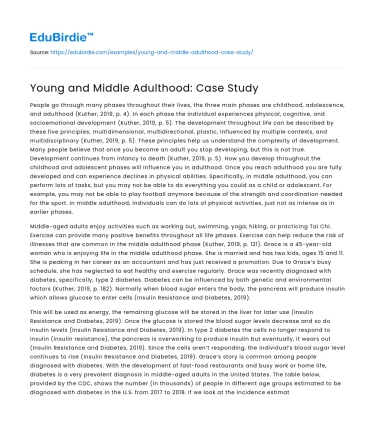People go through many phases throughout their lives, the three main phases are childhood, adolescence, and adulthood (Kuther, 2019, p. 4). In each phase the individual experiences physical, cognitive, and socioemotional development (Kuther, 2019, p. 5). The development throughout life can be described by these five principles; multidimensional, multidirectional, plastic, influenced by multiple contexts, and multidisciplinary (Kuther, 2019, p. 5). These principles help us understand the complexity of development. Many people believe that once you become an adult you stop developing, but this is not true. Development continues from infancy to death (Kuther, 2019, p. 5). How you develop throughout the childhood and adolescent phases will influence you in adulthood. Once you reach adulthood you are fully developed and can experience declines in physical abilities. Specifically, in middle adulthood, you can perform lots of tasks, but you may not be able to do everything you could as a child or adolescent. For example, you may not be able to play football anymore because of the strength and coordination needed for the sport. In middle adulthood, individuals can do lots of physical activities, just not as intense as in earlier phases.
Middle-aged adults enjoy activities such as working out, swimming, yoga, hiking, or practicing Tai Chi. Exercise can provide many positive benefits throughout all life phases. Exercise can help reduce the risk of illnesses that are common in the middle adulthood phase (Kuther, 2019, p. 121). Grace is a 45-year-old woman who is enjoying life in the middle adulthood phase. She is married and has two kids, ages 15 and 11. She is peaking in her career as an accountant and has just received a promotion. Due to Grace’s busy schedule, she has neglected to eat healthy and exercise regularly. Grace was recently diagnosed with diabetes, specifically, type 2 diabetes. Diabetes can be influenced by both genetic and environmental factors (Kuther, 2019, p. 182). Normally when blood sugar enters the body, the pancreas will produce insulin which allows glucose to enter cells (Insulin Resistance and Diabetes, 2019).
Save your time!
We can take care of your essay
- Proper editing and formatting
- Free revision, title page, and bibliography
- Flexible prices and money-back guarantee
This will be used as energy, the remaining glucose will be stored in the liver for later use (Insulin Resistance and Diabetes, 2019). Once the glucose is stored the blood sugar levels decrease and so do insulin levels (Insulin Resistance and Diabetes, 2019). In type 2 diabetes the cells no longer respond to insulin (insulin resistance), the pancreas is overworking to produce insulin but eventually, it wears out (Insulin Resistance and Diabetes, 2019). Since the cells aren’t responding, the individual’s blood sugar level continues to rise (Insulin Resistance and Diabetes, 2019). Grace’s story is common among people diagnosed with diabetes. With the development of fast-food restaurants and busy work or home life, diabetes is a very prevalent diagnosis in middle-aged adults in the United States. The table below, provided by the CDC, shows the number (in thousands) of people in different age groups estimated to be diagnosed with diabetes in the U.S. from 2017 to 2018. If we look at the incidence estimate of people diagnosed for each age group, we see that middle-aged adults (45 to 64) are diagnosed at a higher rate. The incidence estimate for people ages 18 to 44 was 4.3 thousand, for ages 45 to 64 the incidence estimate was 9.9 thousand and for people ages 65 and older the incidence estimate was 8.8 thousand. Based on the data, diabetes is a more prevalent diagnosis for people during middle adulthood, but it continues to influence adults later on in life. Not only does diabetes affect different age groups but it can also influence men and women differently.
Women tend to be diagnosed at the same rate as men (Kuther, 2019, p. 182). If we look at the table, we see that there is only a 0.7 thousand (700) difference in the incidence estimate of men and women. Although, women with diabetes tend to experience a greater risk of heart attack or stroke than men (Kuther, 2019, p. 182). Diabetes can be prevented by exercising regularly, maintaining a healthy weight, and having a healthy diet (Kuther, 2019, p. 182). Managing diabetes is influenced greatly by having a low-sugar diet and monitoring glucose levels (Kuther, 2019, p. 182). Managing diabetes is not easy for everyone and will require a lot of life changes. Bronfenbrenner’s biological systems theory contains multiple systems that contribute to an individual’s development (Kuther, 2019, p. 21). Microsystems is a part of this theory and it can help people with diabetes develop a new healthy way of life. Microsystems are a person’s direct physical and social environment (family, colleagues, church) (Kuther, 2019, pp. 21-22). The family of the individual with diabetes can help support them to eat healthily. They can avoid buying or tempting the individual with unhealthy foods and encourage them to exercise regularly. Both family and colleagues can be aware of low or high blood sugar level symptoms and remind the individual to check their glucose level throughout the day. If an individual is religious, they can seek support and help from their church.
Diabetes is a very common disease in the United States. Understanding diabetes and knowing its symptoms will help me in my future career as a nurse. This knowledge will also help me educate my family on the importance of healthy eating and regular exercise. Many people just like Grace, get too busy in life and neglect to take care of their bodies. Diabetes occurs more often in middle-aged adults and has lasting effects throughout life. It is important to develop healthy habits to prevent the development of this disease. It is never too late to start!






 Stuck on your essay?
Stuck on your essay?

